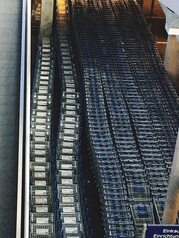Connectivity and Urban Environment: Key to Real Estate Valuation

Connectivity in the urban environment is a determining factor that directly influences real estate valuation. In a world where time is money, ease of access to services, transportation, and technology translates into a higher demand for strategically located properties. Understanding how these elements impact the value of a property is not only essential for buyers and investors but also for those looking to maximize their long-term returns. Let’s discover together how connectivity becomes the key to enhancing your real estate investment.
The importance of road infrastructure in real estate valuation
Road infrastructure is a fundamental pillar in real estate valuation, as it determines the accessibility of a property and its connection to the rest of the urban environment. A well-designed and maintained road system not only facilitates the daily transportation of residents but also allows for a constant flow of potential buyers and investors. Properties located near major roads or in areas with good public transport connections tend to have higher demand, which directly translates into an increase in their value. Therefore, investing in areas with adequate road infrastructure can be an effective strategy to maximize return on investment.
Moreover, the quality of road infrastructure also influences other important aspects such as safety and the quality of life of residents. Areas with good access to basic services like hospitals, schools, and shops tend to be more attractive to families, which further increases their real estate value. Urban planning that prioritizes the development of adequate infrastructure not only improves connectivity but also fosters a sustainable and functional environment. In this regard, understanding how these factors interrelate can help investors identify promising opportunities in the real estate market and make informed decisions when acquiring properties.
2. Access to public transportation: A decisive factor
Access to public transportation has become a decisive factor in the valuation of properties. Areas with metro stations, bus stops, or trams tend to experience much higher demand, as they facilitate the daily commute of their residents. This convenience not only benefits those who use transportation to go to work, but also attracts people who value the ability to move around the city without relying on a private vehicle. In this sense, proximity to public transportation lines can significantly increase the appeal and value of a property.
Additionally, efficient access to public transportation promotes a more sustainable and accessible lifestyle. Well-connected areas tend to be more dynamic and vibrant, attracting both young professionals and families seeking quality of life. This constant flow of people generates an active urban ecosystem, where businesses and services thrive due to daily influx. Therefore, investing in properties located near transportation infrastructure is not only a smart strategy from a financial perspective but also an effective way to contribute to community development and the overall well-being of the urban environment.
3. Proximity to essential services: Beyond the basics
Proximity to essential services goes beyond simply having supermarkets, schools, and hospitals around the corner. Nowadays, buyers seek a comprehensive experience that includes access to recreational areas, cultural centers, and diverse dining options. Quality of life has become a primary factor for modern families, who value not only the home itself but also the surrounding environment. This trend has led to an increase in demand for properties located in areas that offer a balanced combination of comfort and leisure, thus raising their valuation in the real estate market.
In addition, proximity to essential services directly impacts residents' perception of time and quality of life. Rooms closer to public transportation or subway stations not only facilitate daily commutes but also provide a sense of connection to the rest of the city. This is particularly attractive to young professionals and families who prioritize an active and connected lifestyle. When evaluating a property, considering these aspects can be decisive for its future valuation; places where people can meet their daily needs without complications tend to maintain or increase their value over time.
4. Technology and digital connectivity: The new standard of living
Technology and digital connectivity have redefined the concept of home, becoming a vital aspect in real estate valuation. Nowadays, properties that offer high-speed internet access, home automation systems, and smart solutions are becoming more attractive to buyers. The demand for spaces that integrate technology to facilitate daily life not only improves the quality of life for their inhabitants but also increases resale value by positioning these properties as preferred options in a competitive market. The ability to control aspects of the home from mobile devices or receive services through digital platforms has raised the expectations of the modern consumer.
Moreover, digital connectivity goes beyond the individual characteristics of a property; it is also intrinsically linked to the urban environment. Areas with good technological infrastructure, such as 5G networks and access to advanced digital services, tend to attract both young professionals and families seeking comfort and efficiency. This phenomenon has led to a shift in migration patterns towards cities where connectivity is a priority. Therefore, investing in properties located in areas with high connectivity not only ensures a contemporary lifestyle for its occupants but also represents a strategic decision for those interested in maximizing the long-term value of their investment.
5. Public spaces and their impact on property values
Public spaces are a vital component in shaping the urban environment, and their quality significantly influences the value of surrounding properties. Parks, squares, recreational areas, and pedestrian zones not only enhance the aesthetics of a locality but also foster a sense of community and well-being among residents. Proximity to these green spaces can be seen as a unique attraction for potential buyers and tenants, which raises demand and, consequently, the property value. Thus, properties near well-designed public spaces tend to experience faster appreciation compared to those located in areas lacking such amenities.
In addition to improving the quality of life for its inhabitants, public spaces play a crucial role in urban connectivity by facilitating access to various social and cultural activities. A neighborhood with good access to theaters, museums, or local markets tends to attract a more diverse and dynamic demographic profile. This vibrant environment not only makes properties more desirable, but it can also incentivize additional investments in infrastructure and local services. In summary, when considering real estate valuation, it is essential to take into account how public spaces can transform both the visual and functional appeal of a property within the urban context.
6. Urban versus rural areas: Comparative analysis of added value
The comparative analysis of added value between urban and rural areas reveals significant differences in real estate valuation. Urban areas, characterized by their population density and access to advanced infrastructure, tend to experience constant price growth due to the high demand for housing close to essential services such as schools, hospitals, and shopping centers. Connectivity in these areas is reflected not only in efficient public transportation but also in the availability of modern technologies that facilitate remote work and entertainment. This combination creates a dynamic environment where properties tend to appreciate more quickly.
On the other hand, rural areas present a different landscape. Although they are traditionally perceived as less valuable due to lower population density and limited access to services, there is a growing interest from buyers seeking tranquility and more spacious environments. The improvement in digital connectivity has allowed many people to work from home, increasing the attractiveness of these places. However, this appreciation may be slower and will depend on the development of key infrastructure that effectively connects these areas with urban centers. In this regard, both the advantages and challenges present in each type of area must be considered when evaluating the potential real estate appreciation.
7. Global trends in urban connectivity and their local application
Urban connectivity has evolved significantly in recent years, driven by technological advancements and a shift in citizen expectations. Cities are adopting smart solutions that integrate public transport, pedestrian mobility, and digital infrastructure, creating more cohesive and accessible environments. From applications that facilitate vehicle sharing to real-time information systems about public transport, these global trends are redefining how we move within our urban areas. The implementation of 5G networks is also enabling greater interconnection between devices, optimizing not only personal communication but also traffic management and public services.
The local application of these trends can have a direct impact on real estate valuation. Properties located in areas with high connectivity tend to maintain their value and attract buyers and tenants seeking convenience and efficiency. Additionally, communities that prioritize sustainability and access to urban services through innovative technologies not only enhance the quality of life for their residents but also become focal points for real estate investments. In this context, understanding how to adapt global trends to local needs can be key to maximizing return on investment and ensuring balanced urban development that benefits both individuals and entire communities.
8. How to assess connectivity before buying a property
When evaluating connectivity before purchasing a property, it is essential to consider the proximity to public transportation networks such as buses, trains, and metro. The availability of these options not only enhances personal mobility but also increases the area's appeal to future buyers or renters. It is advisable to research the routes and frequencies of these services, as well as the ease of access to them from the property. A well-connected neighborhood is often an indicator of higher valuation in the real estate market, as it allows residents to travel quickly and comfortably to their workplaces, study locations, and leisure activities.
In addition to public transportation, other forms of connectivity that impact the quality of urban life must be analyzed. This includes access to essential services such as supermarkets, hospitals, schools, and recreational spaces. Good technological infrastructure also plays a key role; checking for access to high-speed internet is essential in an increasingly digitalized world. Finally, consider future urban projections and development plans in the area; this can provide insights into how connectivity will evolve in the coming years and its potential impact on real estate valuation.
9. Future of urban development: Projects that transform the real estate landscape
The future of urban development is marked by innovative projects that transform the real estate landscape, integrating connectivity and sustainability as fundamental pillars. These projects not only aim to meet the growing housing demand but also focus on creating dynamic and functional environments that enhance the quality of life for their inhabitants. From residential developments with green spaces and common areas to commercial complexes that promote collaborative work, each initiative is designed to maximize the connection between people and their surroundings, which is crucial for increasing the value of surrounding properties.
Additionally, technology plays a crucial role in this urban transformation. The implementation of smart solutions, such as automated transportation systems and digital platforms for public service management, is redefining how we interact with our cities. Projects that incorporate these technologies are not only more attractive to buyers and tenants but also drive real estate appreciation by offering modern amenities and greater operational efficiency. Thus, the future of urban development presents a unique opportunity for visionary investors willing to bet on initiatives that prioritize connectivity and community well-being.



